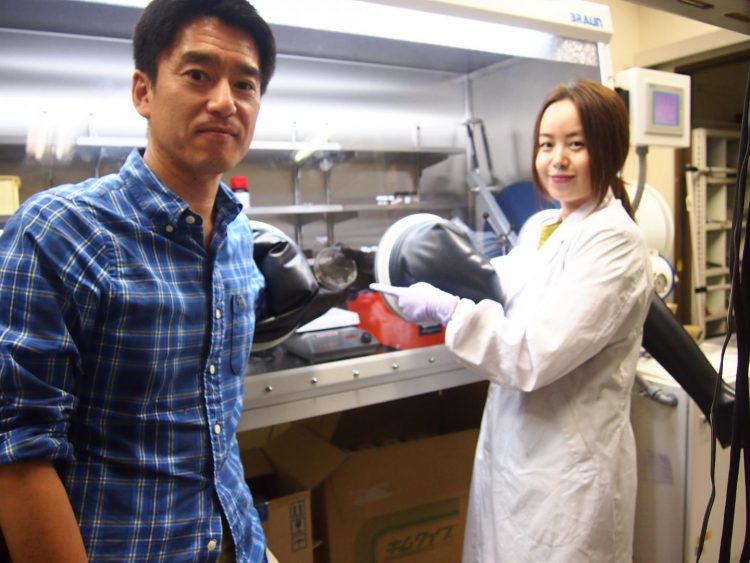Next-generation illumination using silicon quantum dot-based white-blue LED

Professor Ken-ichi Saitow, Natural Science Center for Basic Research and Development, Hiroshima University and Graduate student Yunzi Xin, Graduate School of Science, Hiroshima University, have fabricated an Si QD hybrid LED. Credit: Natural Science Center for Basic Research and Development, Hiroshima University
A hybrid LED is expected to be a next-generation illumination device for producing flexible lighting and display, and this is achieved for the Si QD-based white-blue LED.
For details, refer to “White-blue electroluminescence from a Si quantum dot hybrid light-emitting diode,” in Applied Physics Letters; DOI: 10.1063/1.4921415.
The Si QD hybrid LED was developed using a simple method; almost all processes were solution-based and conducted at ambient temperature and pressure. Conductive polymer solutions and a colloidal Si QD solution were deposited on the glass substrate.
The current and optical power densities of the LED are, respectively, 280 and 350 times greater than those reported previously for such a device at the same voltage (6 V). In addition, the active area of the LED is 4 mm2, which is 40 times larger than that of a typical commercial LED; the thickness of the LED is 0.5 mm.
Professor Saitow stated, “QD LED has attracted significant attention as a next-generation LED. Although several breakthroughs will be required for achieving implementation, a QD-based hybrid LED allows us to give so fruitful feature that we cannot imagine.”
###
Regarding quantum dots (QDs): Semiconductor QDs can produce full-color luminescence through tuning of the particle size. QDs have attracted significant attention as potential components of next-generation solid-state light sources, including LEDs.
Media Contact
All latest news from the category: Physics and Astronomy
This area deals with the fundamental laws and building blocks of nature and how they interact, the properties and the behavior of matter, and research into space and time and their structures.
innovations-report provides in-depth reports and articles on subjects such as astrophysics, laser technologies, nuclear, quantum, particle and solid-state physics, nanotechnologies, planetary research and findings (Mars, Venus) and developments related to the Hubble Telescope.
Newest articles

Bringing bio-inspired robots to life
Nebraska researcher Eric Markvicka gets NSF CAREER Award to pursue manufacture of novel materials for soft robotics and stretchable electronics. Engineers are increasingly eager to develop robots that mimic the…

Bella moths use poison to attract mates
Scientists are closer to finding out how. Pyrrolizidine alkaloids are as bitter and toxic as they are hard to pronounce. They’re produced by several different types of plants and are…

AI tool creates ‘synthetic’ images of cells
…for enhanced microscopy analysis. Observing individual cells through microscopes can reveal a range of important cell biological phenomena that frequently play a role in human diseases, but the process of…





















